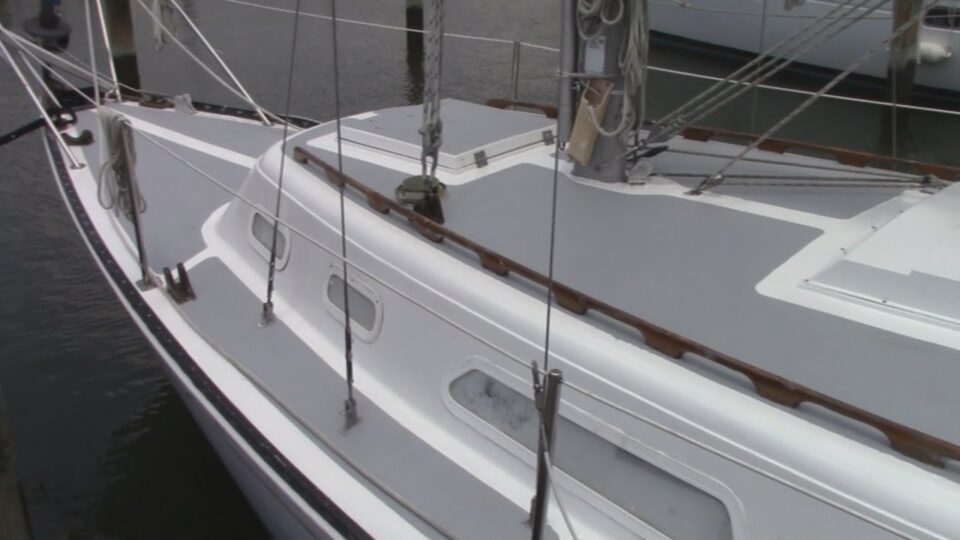Best Non Skid Boat Deck Paints
Painting your boat’s deck can be a challenging task. In this article, we will take a look at the Best Non-Skid Deck Paint for your boat or sailboat. For this article, I asked some boaters friends of mine, marine product professionals, and some online forum buddies of mine and well as my personal experiences with some of the following products.
A good non-skid boat deck paint provides a slip-resistant surface on your boat that is essential when you try to move on your deck even at the best of conditions. In foul weather, a non-skid coat of paint could be the difference between life and death. These anti-slip paints will increase friction and reduce the likelihood of a fall overboard.
Kiwi Grip Non-Skid Deck Paint – Overall The Best Non-Skid Boat Deck Paint
If you’re DIYing it. Go with Kiwi Grip. It’s overall the best non-skid deck paint for your boat, and as long as you plan well, you can do a whole boat, including the cockpit, in about three sessions. But be warned, it’s expensive stuff. It costs around 150$ per gallon (4 Liters), and each gallon can of KiwiGrip can cover about 80 square feet.
I like the Kiwi Grip because it’s water-based, so easy to clean up and deal with. For the non-skid effect, you just use a special roller, no sand or crushed shell or whatever people add for the non-skid effect, which makes for an easy application. It probably the easiest material to work with to give your boat the desired non-skid effect.
It is a good idea to experiment on a piece of plywood before tackling your deck. Kiwi Grip is easy to mess up like just about anything! Practice makes almost perfect! But do not worry, even a bad Kiwi Grip job still works great; making it look pretty is about finesse and practice. A Blue Paper Masking Tape will be your best friend in this application, so you can make the edges perfect.
I had very good results with Kiwi Grip; follow directions carefully, don’t let it freeze, and practice, for the best possible results, apply the paint on a dry and hot day. Remember, you can always go over any part that isn’t perfect again. And last but not least, do not forget to wear a mask.
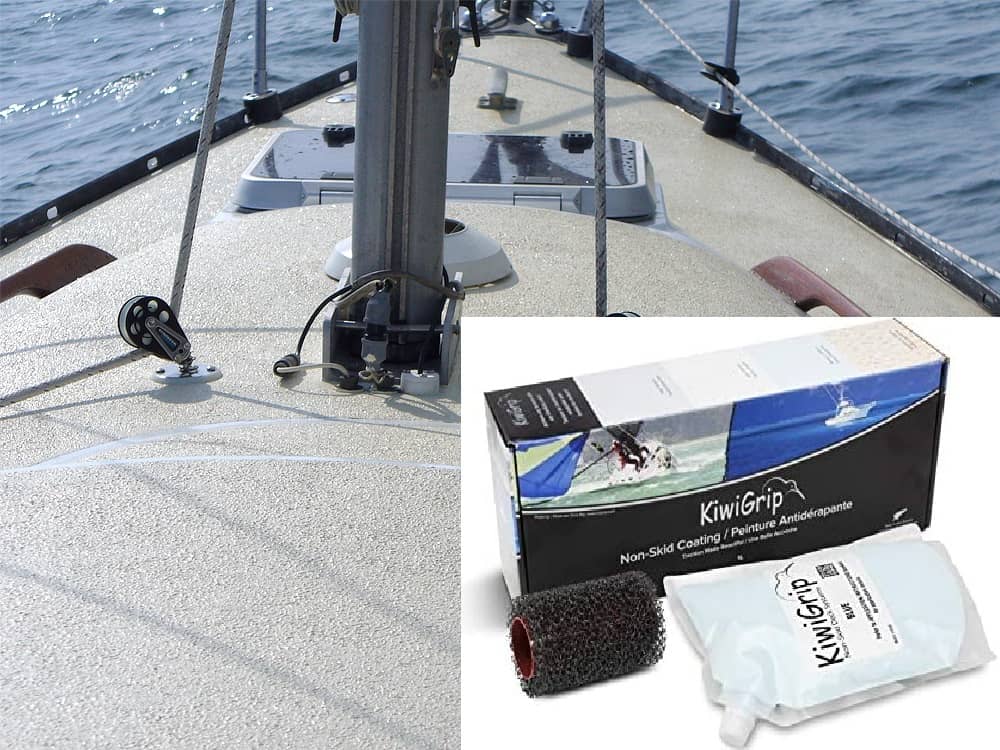
TUFF Coat Non-Skid Coating
This type of paint is becoming very popular lately, and for a good reason, TUFF Coat is easy on your feet, highly durable, and has the added benefit of looking good as well. A friend of mine has used it for about 10 years now on his catamaran sailboat. He recoated once, 4 years ago, and is very happy with it. The two-part primer they have for it is very runny, so be careful with it. It sticks to itself great, though. It stretches a bit, which can hide minor Gelcoat cracking, and is very soft on the knees and bare feet because of the rubber particles.
For proper application, use a drill mixer to thoroughly stir and suspend all the rubber non-skid particles into the paint. Then, pour the coating into a paint tray and load your roller with enough paint. For maximum non-skid effect, you can use a paint roll similar to the one that is used for the Kiwi Grip application. That way, you will get the benefits of both the texture and the non-skid particles.
You will need around 1 Gallon of this stuff to cover 150 square feet of deck surface; per coat, 2 necessary, 3 recommended.
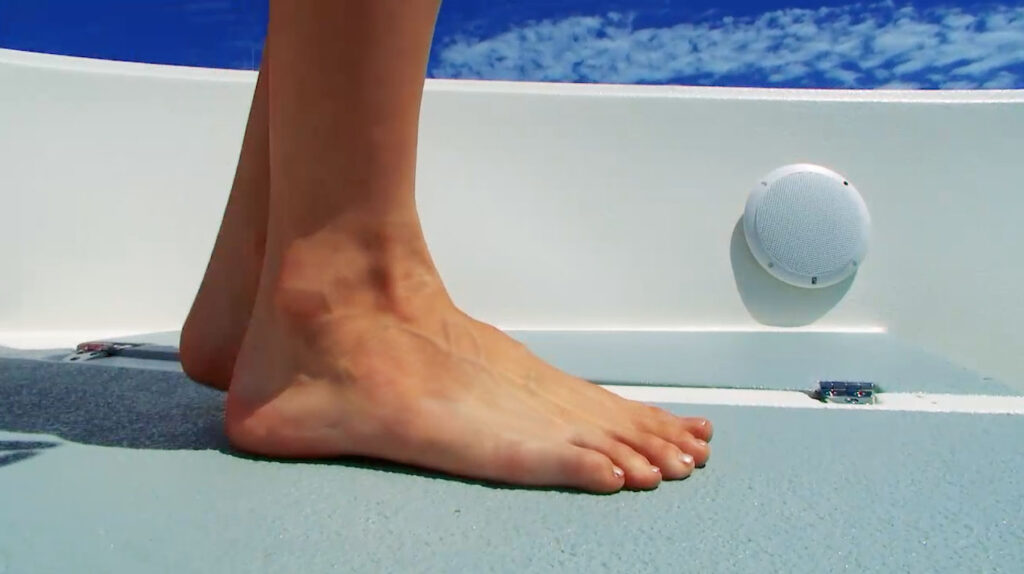
TotalBoat TotalTread Non-Skid Deck Paint
This is another single part nonskid paint for your deck, so you do not need to mix anything yourself. Just remember to stir very thoroughly before applying to ensure the solvents and non-skid particles are mixed in evenly, preferably with a paint mixer. This paint gives a flat finish with a non-slip texture, so if you do not like the texture that Kiwi Grip has, this is probably the way to go. It comes in 3 colors white, gray, and sand beige. To get a good result, you will need about two coats of paint, but if you decide that the desired effect is not there yet, you can add an extra coat for a more slip-resistant surface.
Before applying, make sure you clean the fiberglass properly with plenty of water and soap (let it dry) or prime first with TotalBoat Topside Primer. You can use both a brush or roller, but I would recommend rollers to get a more even result.
This product is very user friendly since the application is as straight forward as painting a wall at your home. As a pro tip, it is better to apply multiple thinner coats of paint instead of one or two thicker ones. Also, give the paint one or two days to dry before you apply another coat, depending on temperature and humidity.
Keep in mind that you will need around 1 Gallon of this stuff to cover 250 square feet of deck surface.
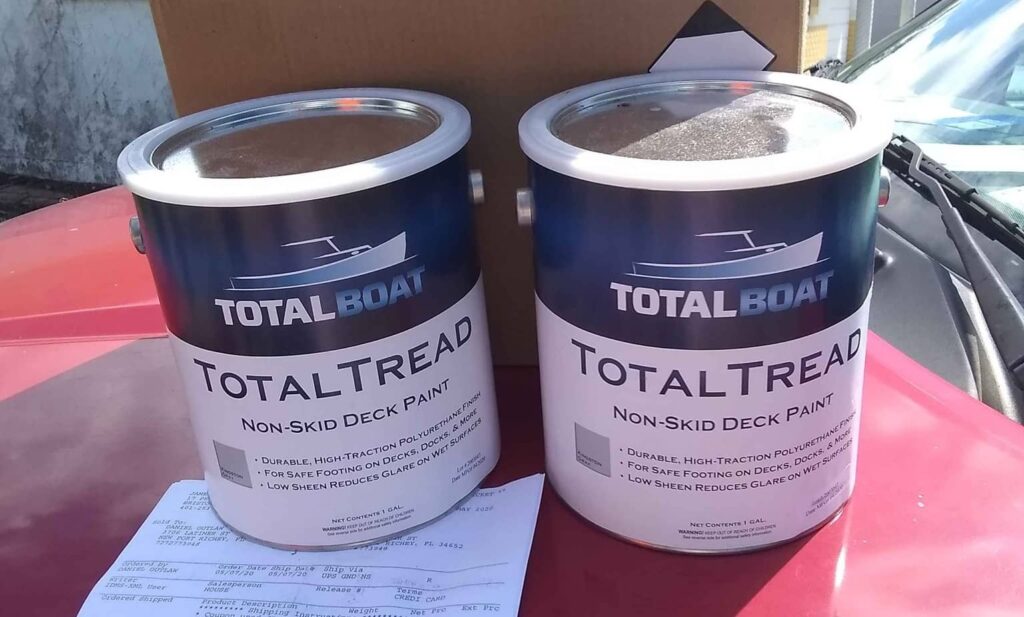
Interlux Interdeck Slip Resistant Deck Paint
This is a one-part polyurethane paint with the non-skid particles already mixed in; just remember to shake the solution well before applying to make sure all the solvents and non-skid particles are mixed in evenly. Also, while you are applying the paint, keep stirring it often because the non-skid will settle down to the bottom of the container. Interdeck has a nice matt finish to reduce sun glare. It may be applied over any type of paint, but you should not apply it over clear epoxy. Clear epoxies must be primed with Epoxy Primekote 404/414 before applying. Make sure to go through and follow directions carefully to make sure you properly prepare and apply the paint. Also, make sure to put tape over the areas you do not want to apply the non-skid paint to get the best looking deck.
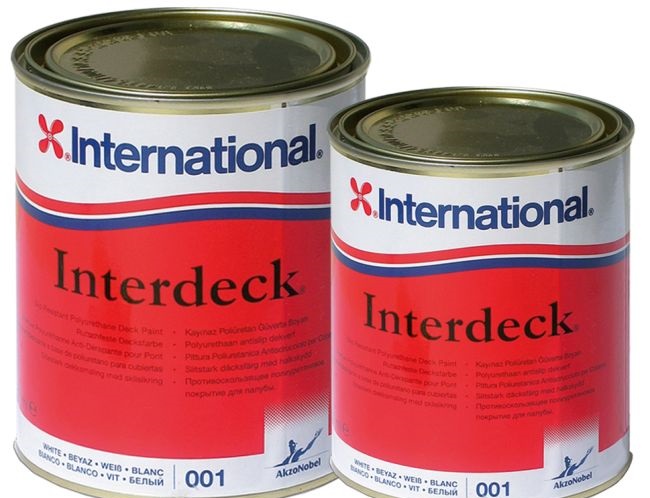
Awlgrip TopCoat With Griptex Non-Skid Additive
This what the professionals recommend when it comes to non-skid deck paints. However, you will have to use Awlgrip TopCoat and also use their Griptex additive. You mix the two products together, preferably with an Electric Paint Mixer, and then the solution can be rolled on.
My boat had previously painted with Awlgrip TopCoat With Griptex Non-Skid Additive. The boatyard this winter sanded it, primed, applied two coats of paint with rollers, then they sprinkled the Griptex with a salt shaker-type when the paint was still wet, vacuumed the loose Griptex particles off, and then rolled on two more Awlgrip TopCoat coats on. I found it smart and intuitive instead of mixing more material than you need and wasting it. Awlgrip with Griptex additive will look the best, but its grip is inferior to Kiwi Grip.
AwlGrip White Base With Crusted Walnut Shells
I have to say this is a very controversial way to apply a non-skid coat on your boat. However, a friend of mine has done it, and I have been on this boat, and I must say that the result is great. It feels good on your feet, it has the desirable non-skid effect and is also pretty affordable.
You apply it the same way you would apply the Griptex Non-Skid Additive to your AwlGrip TopCoat. The best way to apply it is to coat a thick layer of AwlGrip on your deck and then sprinkle the Crusted Walnut Shells on the wet paint; make sure to sprinkle the shells evenly. Let it rest overnight, and then vacuum the loose Crusted Walnut Shells off. Then, apply two more coats of Awlgrip TopCoat.
>>Also Read: Best Boat Coatings
Tips For Appling Any Non-Skid Paint On Your Boat
There are two types of people when it comes to preparing your deck for paint application. Many people sand their whole deck, and then they vacuum and clean it. The other ones just use a good deck cleaner and plenty of water to thoroughly degrease and clean the deck. That second way is ok if it is the first time you are applying a non-skid paint on your deck. However, you must remove all chips and peels from the deck’s surface. If you are reapplying, I would recommend removing the old coat first or at least sanding the old coat off as much as possible.
Pick a day that is not overly hot and sunny nor cold and cloudy. You do not want your paint to dry up too quickly nor to stay wet for two days straight. However, make sure to leave the paint cure at least for hours before you apply another coat.
Use a paint mixer drill attachment to stir the paint before each application, especially on two-part non-skid paints. I would recommend this on pretty much all the paints featured in this article, but you can get away without using one on the Kiwi Grip because there are no non-skid particles suspended on that type of paint.
Lastly, you will need a paint set that includes paint rollers, paintbrushes, and a paint tray. Also, get a Blue Paper Masking Tape to help you protect the non-skid areas and help achieve the best possible look.
Final Thoughts
The Best Non-Skid Boat Deck Paints is the Kiwi Grip, hands down; it is easy to apply and will get you the best result. To spruce up your boat’s deck with great functionality, you need to apply a new coat of non-skid paint. You’ll be able to change the color (Kiwi Grip comes in Black, Blue, Cream, Grand, and White) and dress it up while also adding a layer of protection to your deck’s surface. Old, dull fiberglass surfaces like your deck can become fresh and clean in very little time and effort. The Best Non-Skid Boat Deck Paint will also protect fiberglass surfaces from liquids, repel stains, and provide a nonslip surface for safe walking. Also, if your fiberglass has developed chips and spider cracks over the years, a coat of paint will cover them right up and your boat will appear as good as new.
Also, if you are not sure you want to paint your deck them you could consider a Non-Skid Self-Adhesive Foam Teak Marine carper for your boat.
